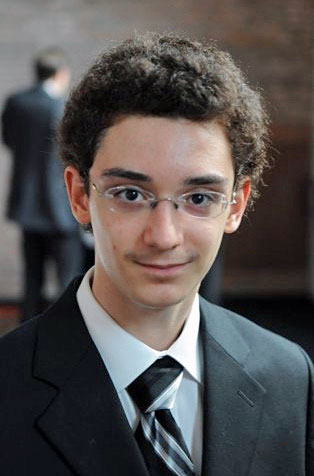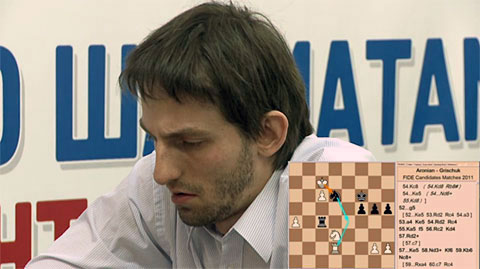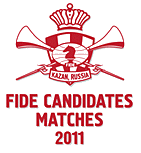
| |
| May 2011 |
| M |
T |
W |
T |
F |
S |
S |
| |
|
|
|
|
|
1 |
| 2 |
3 |
4 |
5 |
6 |
7 |
8 |
| 9 |
10 |
11 |
12 |
13 |
14 |
15 |
| 16 |
17 |
18 |
19 |
20 |
21 |
22 |
| 23 |
24 |
25 |
26 |
27 |
28 |
29 |
| 30 |
31 |
|
|
|
|
|
|
From 3 to 27 May 2011 the FIDE Candidates matches are being held in Kazan,
the capital of the Republic of Tatarstan, with eight strong GMs competing to
qualify as Challenger for the 2012 World Champion match. Time controls in the
four regular games are 120 minutes for the first 40 moves, 60 minutes for the
next 20 moves and then 15 minutes for the rest of the game, plus an additional
30 seconds per move starting from move 61. In case of a tie there will be four
rapid chess games, and if the tie is still not broken then up to five two-game
blitz matches 5'+3". Finally there may be a sudden-death final decider.
The prize fund of the candidates is 500,000 Euros.
Scoreboard
| |
Nat. |
Rtng |
1 |
2 |
3 |
4 |
5 |
6 |
7 |
8 |
Tot. |
Perf. |
| Levon Aronian |
ARM |
2808 |
½ |
|
|
|
|
|
|
|
0.5 |
|
| Alexander Grischuk |
RUS |
2747 |
½ |
|
|
|
|
|
|
|
0.5 |
|
| |
Nat. |
Rtng |
1 |
2 |
3 |
4 |
5 |
6 |
7 |
8 |
Tot. |
Perf. |
| Vladimir Kramnik |
RUS |
2785 |
½ |
|
|
|
|
|
|
|
0.5 |
|
| Teimour Radjabov |
AZE |
2744 |
½ |
|
|
|
|
|
|
|
0.5 |
|
| |
Nat. |
Rtng |
1 |
2 |
3 |
4 |
5 |
6 |
7 |
8 |
Tot. |
Perf. |
| Veselin Topalov |
BUL |
2775 |
½ |
|
|
|
|
|
|
|
0.5 |
|
| Gata Kamsky |
USA |
2732 |
½ |
|
|
|
|
|
|
|
0.5 |
|
| |
Nat. |
Rtng |
1 |
2 |
3 |
4 |
5 |
6 |
7 |
8 |
Tot. |
Perf. |
| Boris Gelfand |
ISR |
2733 |
½ |
|
|
|
|
|
|
|
0.5 |
|
| Shak. Mamedyarov |
AZE |
2772 |
½ |
|
|
|
|
|
|
|
0.5 |
|
Round one commentary
By GM Fabiano Caruana

Aronian,Levon - Grischuk,Alexander [D87]
Candidates, 05.05.2011 [Caruana,F]
1.d4 Nf6 2.c4 g6 3.Nc3 d5. Already a surprise! Although Grischuk has
played the King's Indian many times before, I dont remember having seen him
play the Grunfeld. 4.cxd5 Nxd5 5.e4 Nxc3 6.bxc3 Bg7 7.Bc4 c5 8.Ne2 Nc6 9.Be3
0-0 10.0-0 b6
A rare move, which was played by Vishy Anand against Veselin Topalov in their
World Championship match. At first I was skeptical, but later I came to appreciate
this move, which does little to challenge the centre, but solves the problem
of where to put Black's light-squared bishop, which often can't find a good
place. In comparison, the very popular 10...Bd7 looks really weird to me - I
just can't understand what the bishop is doing there.
11.dxc5. Levon is not impressed, and decides to take the pawn on offer.
When I was analyzing this variation a couple of months ago, I came to the same
conclusion that this was the critical continuation. Perhaps I was a little too
keen to listen to the machine's advice; now I would be less likely to endorse
a move which ruins White's pawn structure and opens all the lines for Black's
pieces. Topalov-Anand, Sofia 2010 continued 11.Qd2 Bb7 12.Rac1 Rc8 13.Rfd1
cxd4 14.cxd4 Qd6 15.d5 Na5 16.Bb5 Rxc1 17.Rxc1 Rc8 18.h3 Rxc1+ 19.Qxc1 e6 ,
and Black had fully equalized.; I hope in the future we seen a return to moves
like 11.f4!? - the caveman's approach to chess, which unfortunately probably
doesn't work very well here.
11...Qc7. Of course Black will not trade queens. 12.Nd4 Ne5 13.Nb5
Qb8. An interesting moment. Black also has the option of playing 13...Qc6,
a move preferred by the computer. 13...Qc6 I imagine the reason Grischuk
avoided this move is because of 14.Bd5 Qxb5 15.Bxa8 Ba6 16.Bd5 e6 17.Bb3 Qxf1+
18.Qxf1 Bxf1 19.Kxf1 Ng4 20.Bd2 bxc5 21.h3 Rd8 22.Rd1 Ne5 23.Ke2 , when we reach
a position where White's two bishops grant him a clear and risk free advantage.
Black has no way to neutralize the pressure and will have to suffer for a long
time. 14.Be2
White could have won the exchange with 14.Bd5 Ng4 15.g3 Nxe3 16.fxe3
However, I imagine most people would not be happy to wreck their entire position
in this way. After 16...Bh3 17.Rf2 bxc5 Black will have great compensation.
14...bxc5N. A novelty, but an extremely obvious one. I can't imagine
Levon overlooking this in his preparation, but I'm not sure what he missed,
because Black got a perfect position in a few moves. Previously 14...a6?!
had been played, illogically driving away a misplaced piece. After 15.Na3 bxc5
16.f4 Nd7 17.e5 , Black just has a bad position. White's knight will come to
the dominating c4 square next, and Black's dark-squared bishop is a terrible
piece.
15.f4. White is trying to block the g7-bishop by playing f4 and e5.
Unfortunately, he will never get the chance. 15.Bxc5 a6 16.Nd4 Qc7 gives
Black perfect compensation.; 15.Rb1 at first seems very promising, but the tactics
again work in Black's favour: 15...a6 16.Na3 Qc7 17.f4 Rd8 18.Qc2 Ng4 , and
White will have to give up one of his bishops. 15...Ng4. Of course! This
is why Black postponed playing ...a6.
16.Bxc5. Again Levon decides to grab a pawn, only this time he had no
choice. After 16.Bxg4 Bxg4 17.Qxg4 Qxb5 18.e5 Qc4 White's best move
is to offer a draw as quickly as possible. 16...a6 17.Na3. White has
to continue placing his pieces on strange squares to try to justify his risky
opening strategy. The move 17.Bxg4 leads to a complete annihilation
of all the pieces: 17...Bxg4 18.Qxg4 Qxb5 19.Bd4 Bxd4+ 20.cxd4 Qc4 , and here
the game will soon end in a draw. 17...Qc7 18.Bd4 e5 19.fxe5 Nxe5
Now Black has a great outpost for his knight. After a few small fireworks,
the position has stabilized. White is up a pawn and the bishop is holding his
shaky pawn structure together from d4. However, all Black's pieces are perfectly
placed and he should have full positional compensation. 20.Qc1. From
here the queen will go to e3 or f4.
20...Bg4?! I don't like this move, although objectively it's not such
a bad one. Black is down a pawn and decides to go into an endgame – where's
the logic in that? Instead, simple play would have sufficed. After 20...Be6
21.Nc2 Rab8 Black is doing very well. For example, 22.Nb4 (22.Bxa6 Qc6 wins
back a pawn.) 22...Rxb4 23.cxb4 Nf3+ 24.gxf3 Bxd4+ 25.Kh1 Qb6 , and Black
wins the exchange back with a great position.
21.Bxg4 Nxg4 22.Qf4 Qxf4. After 22...Ne5? 23.Nc2 the knight just goes
to d5 and Black will be in big trouble. 23.Rxf4 Ne5 24.Rb1. Although
White's advantage is not large and is very hard to convert, the defensive task
is unpleasant, especially against such a strong techincal player as Levon. 24...Rad8.
I would prefer 24...Rac8 , which prepares ...Nc4. If 25.Rb7 (25.Nc2
is met by 25...Nd3) 25...Nc6 26.Bxg7 Kxg7 Black will be able to make
a draw because of the poor position of the knight on a3. 25.Nc2
25...Nd3? This is where things really start to go wrong for Black.
I'm not sure what Grischuk was trying to achieve with this move, which simply
puts the knight on a useless square. It would be better to place the
knight on a nice outpost with 25...Nc4 , when 26.Rb7 is met by the strong manouver
(26.Rb4 Rc8 keeps control.) 26...Nd6! 27.Rb6 Nb5! , with equality.
In case you were wondering, I didn't find that variation myself.... 26.Rff1.
Levon sees that his rook is attacked and decides to move it. A good decision.
26...Rd7. Grischuk is preventing Rb7, but his play seems too slow. White
is starting to consolidate his position. 27.Rfd1 Nf4 28.Kf2. Aronian
continues playing simply and strongly. This is how the top players play: operating
with logical, harmonious moves! 28...Rc8 29.Ne3 h5. This move, which
doesn't seem to have much of an idea at all, is a clear sign that Black's position
has gone very wrong. White is just a pawn up, with well-placed pieces.
30.Rb6. White has an enormous variety of options at this point (which
is actually more of a disadvantage than anything else!), most of which are of
near equal value. Aronian's move is very reasonable, but he may have had a stronger
alternative. I quite like 30.Rb4!? , which supports the bishop on d4
and prepares Ra4, attacking a6. After 30...Ne6 White has the option between
the simple 31.e5 or 31.Nd5 Nxd4 32.Nb6! Rxc3 33.Nxd7 Rc2+ 34.Kf1 , although
I imagine it isn't easy to calculate this variation.
30...Ne6 31.Bxg7 Rxd1 32.Nxd1 Kxg7 33.Ke3

33...Nc5 34.Rd6 a5 35.c4
White begins pushing his pawns. Black can't do much about it at all. In such
situations the best thing to do is wait and hope your opponent gives you a chance
for counterplay.

A powerful computer analysing the games and tracking the evaluation in a
bar chart. You can
watch the games with engine commentary live on a regular browser on our
live broadcast site.
35...a4 36.Kd4 Ne6+ 37.Kc3 Rb8 38.Rd5 Nf4 39.Rd2 Ne6 40.Rb2 Rd8 41.Nf2 a3
42.Rd2 Rb8 43.Nd3 Rb1 44.c5 Kf6 45.c6 Ke7 46.Nb4 Rc1+
47.Kb3? A strange mistake. I imagine both players were already tired
at this point. Levon has played the game perfectly up to this point, but now
he allows unnecessary counterplay. Instead 47.Nc2! , just wins on the
spot. There are actually no variations to calculate: White will pick up the
a3-pawn with Kb3, and Black cannot do anything at all!
47...Nc5+ 48.Kxa3 Nxe4. Now White has to win the game over again. Black's
pieces are very active, and White seems tied down to the defense of c6.
49.Rd4 Nd6 50.Ka4 Ke6 51.Ka5 Rc5+ 52.Ka6. Again tiredness is playing
a role. I see no reason to avoid 52.Kb6 Rb5+ 53.Ka6 , which forces 53...Rc5
and therefore gains a tempo compared to the game. 52...g5 53.a4 Ke5
54.Rd2? Another mistake making White's task more difficult.
After 54.Rd1 Rc4 55.Rb1 White will continue with Kb6 and win. 54...Rc4 55.Ka5.
White is forced to make this awkward move as a result of his last mistake.
It seems like every move Grischuk gets more and more chances to save the game!
Now 55.Rb2 is met by 55...Kd4 , threatening ...Kc3. This is the reason
the rook had to be on b1! 55...f5 56.Rc2 Kd4 57.Rd2+ Ke5 58.Nd3+ Kf6 59.Kb6
Nc8+ 60.Kb7 Nd6+ 61.Kc7

61...Ne4 62.Ra2 Nc3 63.Rb2 Nxa4 64.Rb4 Rxb4 65.Nxb4 Nc5 66.Kb6 Ne6 67.Nd3
h4
68.h3. A very calm positional move. Actually, this works reasonably
well, but why not just take the knight immediately? 68.c7 would have
won easily. Of course, it is very easy to say this while looking at a computer,
while over the board things are never so simple. 68...Nxc7 69.Kxc7, and Black's
pawns are not strong enough to make a draw. 69...f4 70.Kd6 Kf5 71.Kd5 g4 72.Kd4
g3 73.hxg3 fxg3 74.Ke3 Kg4 75.Nf4 wins.

This is where Aronian could have won with the move 69.Ne5. Instead he played
69.Nc5=
68...Ke7 69.Nc5? The dramatic end of a long and difficult game. Levon
once again had the win at his fingertips, but let it slip. With just one move
he could have ended Black's stiff resistance. It's interesting to understand
what he missed; I would venture to guess that he felt the pawn ending would
be winning without calculating any details. This often happens after several
hours of play - laziness sets in and you don't feel up to calculating variations.
69.Ne5! would have won. White just threatens to play c7. 69...Kf6
(69...Kd6 70.Nf7+ Ke7 71.Nxg5 decoys the knight on e6.) 70.Nf3 ,
and Black can't stop c7.
69...Nxc5 70.Kxc5 Kd8. And a draw! Black will just trade pawns with
...g4 and come back with his king in time. This was an extremely exciting game.
Aronian played the first half of the game in great style and slowly improved
a slightly better position. However, in the second half he began making many
mistakes and missing win after win. Grischuk, on the other hand, defended extremely
tenaciously after his initial unconvincing play. It will be interesting to see
how the results of this game will affect the rest of the match - if Aronian
will be put on the defensive after this dissapointing draw. 1/2-1/2. [Click
to replay or to download in
PGN]
You can also replay the game in this window:
Note that in the replay window below you can click on the notation to
follow the game.
 |
About the author
Fabiano Luigi Caruana (born July 30, 1992) is a grandmaster
and chess prodigy with dual citizenship of Italy and the United States.
On 15 July 2007 he made his final GM norm and, at the age of 14 years,
11 months, 20 days, the youngest grandmaster in the history of both Italy
and the United States. In the January 2011 FIDE list, he has an Elo rating
of 2721, making him 25th in the world. His current rating is 2714, at
rank 28.
Over the years we have had a lot of fun with Fab Fab (Fabulous Fabiano).
Take a look at this
page, and after that at this
page. We however add a word of caution: the second report contains
images that some readers may find unbearably cute.
|
Links
The games are being broadcast live on the
official web site and on the server Playchess.com.
If you are not a Playchess member you can download ChessBase
Light, which gives you immediate access. You can also use the program
to read, replay and analyse PGN games. |
|
 |
























































